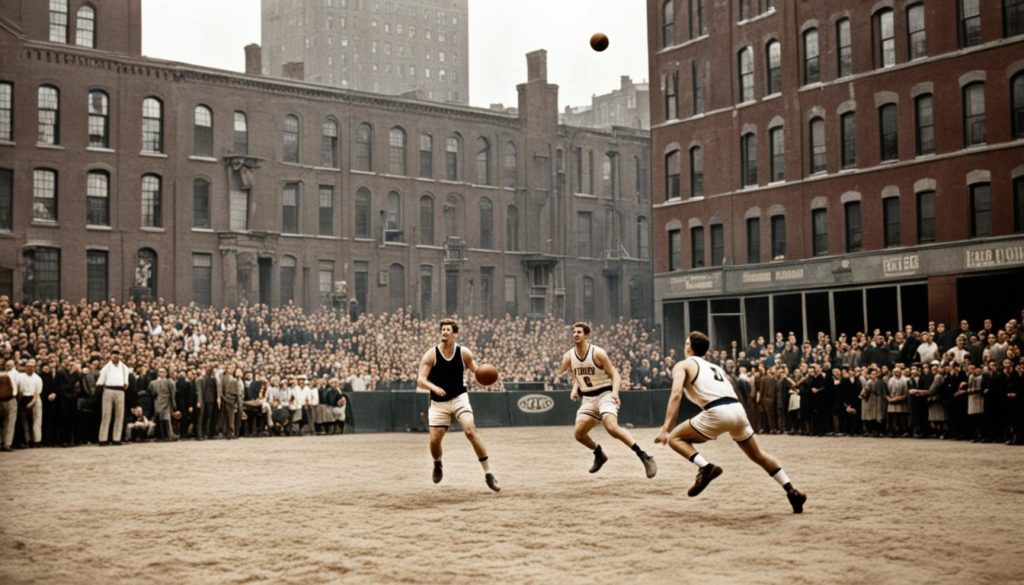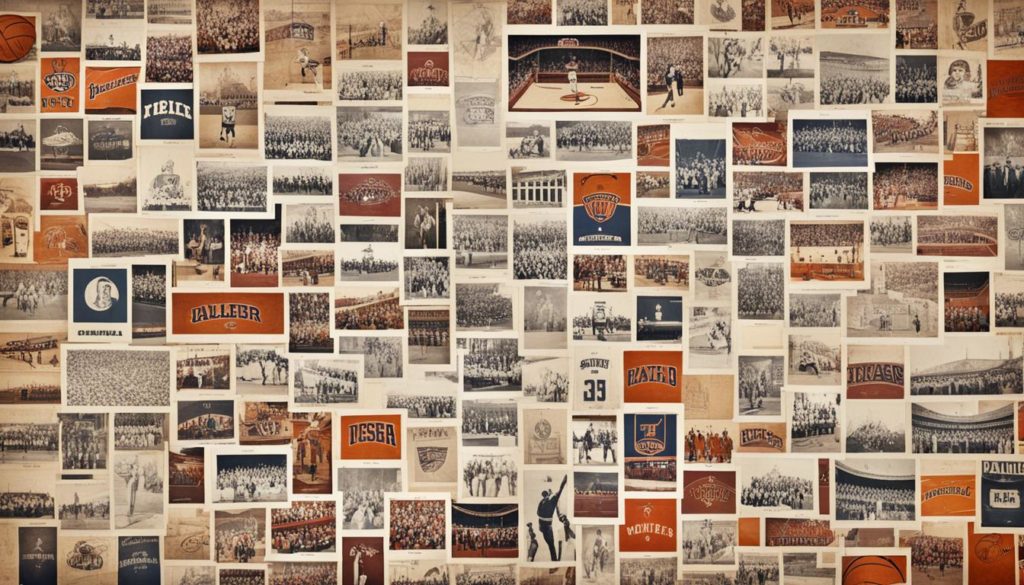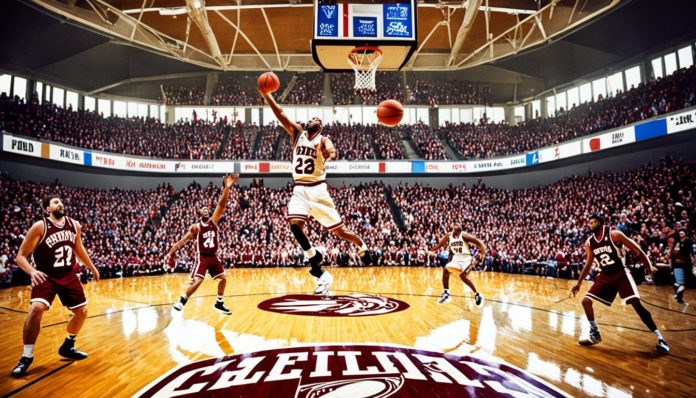Basketball has been a hit around the world for over a century. It started as a simple idea in a gym class and grew into a global sport. This article will take you on a journey through basketball’s history, from its beginnings to its global impact.
It will show how basketball has changed sports and society. You’ll learn about the key moments and people that made basketball what it is today. By the end, you’ll see why basketball is loved by so many people all over the globe.
Key Takeaways
- Basketball was created in 1891 by Dr. James Naismith as a physical education class experiment.
- The sport rapidly gained popularity in the early 20th century, with the first professional league forming in 1946.
- Basketball has become a global sport, with the Olympics including it since 1936 and the sport gaining widespread recognition worldwide.
- Legendary players like Michael Jordan have shaped the modern game and elevated basketball to new heights of popularity.
- The evolution of basketball rules and technology has transformed the sport over time, enhancing the gameplay and viewing experience.
The Birth of Basketball: From a Simple Idea to a Global Phenomenon
In 1891, Dr. James Naismith created basketball at the International Young Men’s Christian Association Training School in Springfield, Massachusetts. He wanted a new indoor game for the cold winter. This game would later become a global phenomenon.
The Origins of Basketball: A Physical Education Class Experiment
Naismith was inspired by other games and used peach baskets as goals, hence the name “basketball.” He set up 13 rules for the game. These rules are still the base of basketball today.
- The goal was to throw the ball into the peach basket, 10 feet up.
- Players could only pass or bat the ball with their hands, not run with it.
- Fouls included pushing, holding, tripping, and hitting the ball with the fist.
Dr. James Naismith’s Innovative Game: Peach Baskets and 13 Rules
Naismith’s game quickly became popular. The use of peach baskets and the 13 rules set the stage for basketball’s growth. Today, it’s a global sport.
“Through basketball, I found a way to unite people of all ages and backgrounds. It was a simple game, but one that had the power to bring people together and inspire them to achieve great things.”
| Year | Event |
|---|---|
| 1891 | James Naismith invents basketball at the International Young Men’s Christian Association Training School in Springfield, Massachusetts |
| 1892 | The first official basketball game is played with two teams of nine players each |
| 1893 | The first basketball court is constructed, measuring 50 feet by 80 feet |
| 1898 | The first professional basketball league is formed, the National Basketball League |
The Early Years: Rapid Growth and Widespread Popularity
After the early history of basketball, the game quickly became popular in the U.S. It was easy to play indoors, making it a hit in colleges, high schools, and communities. This led to its rise as a favorite activity.
Organized leagues and tournaments made the growth of basketball even bigger. The sport won the hearts of people of all ages and backgrounds. It became a favorite for everyone.
Its easy play and versatility helped it grow fast. Being played indoors meant it could be enjoyed all year. This made it popular in many places, from school gyms to community centers.
“Basketball’s early years were marked by an unparalleled surge in popularity, as the game’s accessibility and adaptability captivated the hearts and minds of people across the nation.”
The early history of basketball saw a big rise thanks to dedicated groups. They set rules, organized games, and spread the sport. This made basketball a key part of American culture.

The growth of basketball was amazing. Its charm and fans’ support pushed it to new heights of popularity. This early success set the stage for its global fame.
The History of Basketball: From Amateur to Professional
Basketball became more popular and changed from amateur to professional levels. This change led to college basketball’s rise, with intense rivalries. It also led to professional leagues that made the sport even more popular.
The Rise of College Basketball: Intercollegiate Rivalry
Colleges and universities in the U.S. started their basketball teams, making the sport more popular. These rivalries became key to the sport, drawing fans and boosting athletes’ passion.
Teams like the University of Kentucky, the University of North Carolina, and the University of Kansas became top contenders. They drew in great players and built a strong fan base. These rivalries showed off players’ skills and brought schools together in pride.
The Birth of Professional Basketball Leagues
As college basketball grew, fans wanted a professional league. This led to the NBA and ABA being formed. These leagues let top players show their skills on a big stage, making the sport even more popular.
| League | Founding Year | Key Milestones |
|---|---|---|
| National Basketball Association (NBA) | 1946 |
|
| American Basketball Association (ABA) | 1967 |
|
The rise of professional leagues and college basketball’s success made basketball a big, competitive sport. It moved from being just an amateur activity to a major professional sport.

Basketball’s Global Impact: From Local Courts to International Stardom
Basketball started as a simple experiment in a gym class. Now, it’s a global phenomenon. It became part of the Olympic Games in 1936, gaining worldwide fame. Today, it’s loved everywhere, with teams and leagues in many countries.
The Olympic Journey: Basketball’s Inclusion and Worldwide Recognition
Basketball’s Olympic debut in 1936 was a big moment. It made the sport popular worldwide. This event helped basketball grow and get recognized globally.
The Olympics helped basketball spread worldwide. National teams from all over the world compete, showing their skills and love for the game. These tournaments are huge events, bringing fans together from everywhere.
International stars have made basketball a global favorite. Players like Yao Ming, Dirk Nowitzki, and Giannis Antetokounmpo are known everywhere, inspiring new fans. Their success has broken down cultural barriers, making the sport a global community.
Basketball reaches people in all countries, from local courts to international arenas. It’s a sport that unites people, sharing a love for the game.
Legendary Players Who Shaped the History of Basketball
In basketball history, a few players have made a huge impact. Michael Jordan is one of them. He changed the game forever.
Michael Jordan: The Face of Modern Basketball
Michael Jordan dominated the 1990s with the Chicago Bulls. His skills and performances won over fans worldwide. He’s considered one of the greatest basketball players ever.
His influence went beyond basketball. Jordan’s charisma and marketing skills made the NBA more popular. This helped create a new generation of stars.
Jordan’s career had unforgettable moments. His dunks and game-winning shots are legendary. His impact on basketball is huge, making him the modern face of the sport.
“I’ve missed more than 9,000 shots in my career. I’ve lost almost 300 games. 26 times, I’ve been trusted to take the game-winning shot and missed. I’ve failed over and over and over again in my life. And that is why I succeed.”
Jordan’s determination and commitment have inspired many. His legacy shows the power of hard work and passion in basketball.
The Evolution of Basketball: Rule Changes and Technological Advancements
Basketball has changed a lot over the years. Rule changes and new technology have made the game what it is today. These changes have made the game faster and more exciting, helping it become more popular around the world.
The shot clock was introduced in the 1950s, making the game faster. It forced teams to shoot the ball within a certain time. This change made the game more exciting and dynamic.
In the late 1970s, the three-point line was added. This let players score from farther away, making the game more strategic.
Technology has also changed basketball a lot. Video technology helps referees make better calls and gives coaches and players insights into their games. Advanced analytics have changed how teams plan their strategies, using data to make better decisions.
Wearable technology has also made a big impact. Coaches can track players’ health and performance with devices like heart rate monitors and GPS trackers. Smart basketballs give players feedback on their shots and ball control in real time.
| Rule Change | Year Introduced | Impact on the Game |
|---|---|---|
| Shot Clock | 1954 | Introduced a faster pace and more dynamic gameplay |
| Three-Point Line | 1979 | Added an extra layer of strategy by allowing players to score more points from longer distances |
| Instant Replay | 2002 | Enhanced the accuracy of officiating and provided valuable insights for coaches and players |
| Advanced Analytics | 2000s | Transformed the way the game is approached, with teams and players utilizing data-driven strategies |
| Wearable Technology | 2010s | Allowed for the monitoring of player health and performance, enabling optimization of training regimens and injury prevention |
These changes have not just changed how basketball is played but have also made it more popular worldwide. As the sport continues to evolve, it will be exciting to see what new innovations come next.
“The game of basketball is ever-evolving, and the changes we’ve seen over the years have profoundly impacted the way the sport is played and experienced. From the introduction of the shot clock to the integration of advanced analytics, each advancement has pushed the boundaries of the game and captivated audiences worldwide.”
Conclusion: Basketball’s Enduring Legacy and Future Prospects
Basketball has a long history, starting from a simple experiment in a gym class. It quickly grew popular and became a global sport. Legends like Michael Jordan made it one of the world’s most loved sports.
The sport’s lasting impact shows how it connects people across ages and cultures. It’s known for thrilling moments, player skill, and the bond among players. Basketball has a special way of uniting fans and sparking passion.
The future of basketball looks bright as technology and training improve. This will push the sport to new heights. From local games to pro leagues, basketball will keep bringing excitement and new ideas. It will stay a key part of sports and culture for years to come.
